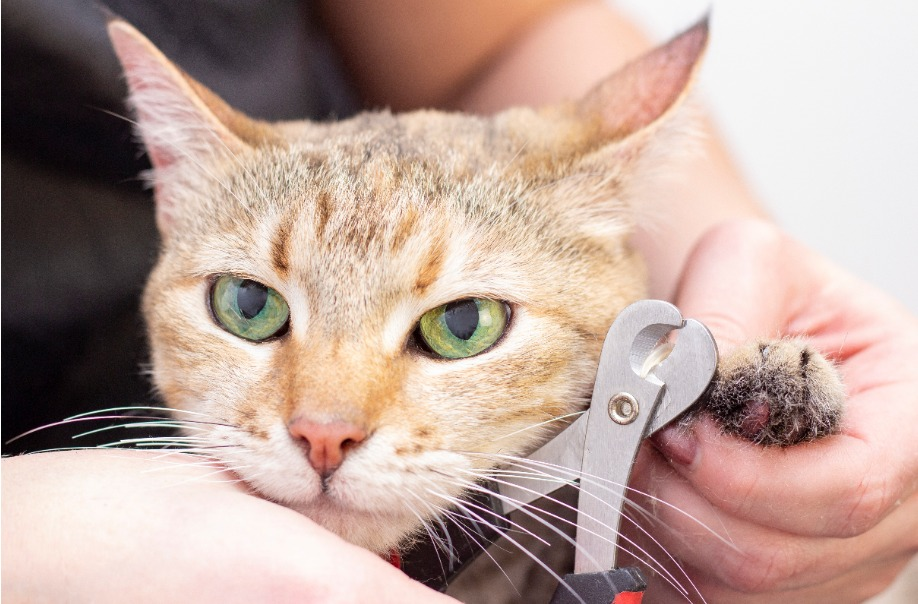Trimming your cat's nails may seem like a challenging task, but it is essential for their health and well-being. It also helps protect your furniture and skin from potential scratches. In this guide, we’ll explain how to safely trim your cat's nails, including specific tips for kittens and more aggressive cats.
Why is it important to trim your cat's claws?
Although cats naturally file their nails, regular trimming offers several benefits for both cats and their owners.
Importance of trimming claws for cats
Cats use their nails to mark territory, hunt, and climb, but excessive nail growth can be harmful. Long nails can:
- Get tangled or caught in fabrics, carpets, or furniture, causing injuries.
- Cause discomfort when walking if they curve into their paw pads.
- Lead to accidental scratches for their owners or other animals.
Benefits of cutting cat nails
- Prevent accidental scratches: For both people and other pets in the household.
- Protect your furniture: Shorter nails do less damage when scratching.
- Improve their health: Keeping their nails well-maintained prevents infections or injuries.
How often should you cut cat nails?
The frequency of nail trims depends on the cat's activity level, age, and behavior. Below is a general guide to determine when it’s time for a trim.
When to start trimming kitten nails?
If you’re wondering when you can start trimming a cat’s nails, the answer is: as early as traykittenhood. Kittens’ nails are finer but grow quickly. Starting young helps them associate nail trims with a normal routine, making the process easier in the future.
How many months between trimming sessions?
On average, a cat’s nails should be checked and trimmed every 3-4 weeks. However, some factors can influence this:
- Indoor cats: Since they don’t file their nails outdoors, they often need more frequent trims.
- Active cats: Cats that scratch frequently may need trims less often.
Other considerations for trimming a kitten nails
For kittens, nails can be trimmed every 2-3 weeks since they grow faster. Use small, kitten-appropriate scissors to avoid injuring them. Only trim the tip of the nail to avoid damaging the nerve inside.
How to safely cut a cat’s nails
Cats require a calm and comfortable environment to feel safe, especially during activities like nail trimming. A clean and well-maintained space, such as their litter tray, is key to their overall well-being. Maintaining their litter tray clean, odor-free, and with a pleasant texture reduces stress. Sanicat’s clumping litter range with active oxygen is ideal for this: its clumping properties, which form compact clumps and with just a little daily maintenance, removing clumps and faeces, help to keep your litter cleaner and fresher for longer. In addition, this litter contains active oxygen which neutralises odour, providing your cat with the comfort he needs at all times. After you have a comfortable litter box and to make this task easier, follow these practical steps and tips.
Necessary tools
- Nail clippers or trimmers designed for cats.
- Nail file (optional).
- Bright light to identify the nerve inside the nail.
- Treats or rewards to calm the cat afterward.
- Towel (for aggressive cats).
Step-by-step to trim claws without causing scratches
- Prepare and calm the cat: Place the cat in a quiet, comfortable spot. Speak to them in a soothing tone to help them relax.
- Gently hold the paw: Press the paw pad lightly to extend the nail.
- Identify the nerve: Look for a pink line inside the nail. Only trim the white tip to avoid injuring the nerve.
- Make quick, precise cuts: Prolonging the process may make the cat anxious.
- Reward the cat: Give them a treat or reward to associate the trim with a positive experience.
How to trim claws on an aggressive cat
- Use a towel: Wrap the cat in a towel to immobilize them, leaving only one paw exposed.
- Do it in sessions: If the cat is very stressed, trim one or two nails per day.
- Seek professional help: In extreme cases, consult a veterinarian or groomer.
Tips for cat claw care
In addition to regular trimming, it’s important to keep your cat’s nails in good condition with these practices:
- Scratching posts: Provide one or more scratching posts to help naturally file their nails.
- Proper toys: Interactive toys help wear down nails during play.
- Regular checks: Examine their nails weekly to ensure they’re not growing too long or damaged.
With patience and practice, trimming your cat’s nails will become a quick and stress-free task. Remember, besides ensuring their well-being, you’re also protecting your home and everyone living with your furry friend.

